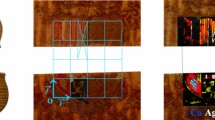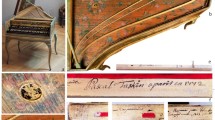Abstract.
The aim of this paper is to report on the investigation of the lituus, an Etruscan musical instrument from the “monumental complex” of Pian di Civita (Tarquinia, Italy), taking advantage of the potentiality of non-invasive portable X-ray fluorescence spectroscopy, video-microscope and radiography. In this case, the use of portable instrumentation was necessary due to the impossibility of transporting the musical instrument out of the museum and also of sampling for eventual laboratory investigation. The study forms part of the European Music Archaeology Project. The lituus is part of a group of objects, found together with an axe and a shield and is now on display in the National Museum of Tarquinia. This extraordinary discovery has no parallels in the Mediterranean area being the only such object whose archaeological context is well known and it is related to the history of the Etruscan town of Tarquinia. The characterization of the metal alloys utilised in creating the objects, never performed before, was crucial to identify the relationship between the three objects, and to understand the manufacturing of the lituus in order to produce a high-quality replica, in accordance with the main goal of the project. Video-microscope was particularly useful for investigating details of the objects and for highlighting the restored areas. XRF analysis revealed the use of copper/tin alloy for lituus, axe and shield. Radiography allowed information to be obtained about the structure of the instrument such as the use of a single piece of sheet for the tube.
Similar content being viewed by others
References
A.A. Both, Yearbook Trad. Music 41, 1 (2009)
B. Del Papa, Suoni dal mondo etrusco (metodo di ricerca), in La musica in Etruria, edited by M. Carrese, E. Li Castro, M. Martinelli (Comune di Tarquinia, Tarquinia, 2010) pp. 205--228
C. Lund, The Sound of Archaeology: Concept, Content, Planning (Musikmuseet, 1974)
M. Bonghi Jovino, Gli scavi nell’abitato di Tarquinia e la scoperta dei “bronzi” in un preliminare inquadramento, in Tarquinia: ricerche, scavi e prospettive, Atti del Convegno “La Lombardia per gli Etruschi”, edited by M. Bonghi Jovino, C. Chiaramonte Trerè (Milano, 1986, 1987) pp. 59--77
M. Bonghi Jovino, Scr. Mediterr. Antico 1, 1 (2007)
G. Bagnasco Gianni, Lo sguardo della musica sui resti del passato. Lavori in corso dell’Università degli Studi di Milano, in La musica in Etruria, edited by M. Carrese, E. Li Castro, M. Martinelli (Comune di Tarquinia, Tarquinia, 2010) pp. 21--32
N.M. Petersen, From North to South. Lurs, Axes and Shields in Ritual Deposits from Denmark and Sweden and the Constellation of Bronzes from the “Monumental Complex” of Tarquinia, in Interregional contacts during the first millennium B.C. in Europe, edited by M. Trefný, B. Jennings, 19th Annual Meeting of European Association of Archaeologists, Pilsen, Czech Republic, September 4–8, 2013 (2017)
C. Pelosi, G. Agresti, P. Holmes, A. Ervas, S. De Angeli, U. Santamaria, Int. J. Conserv. Sci. 7, 847 (2016)
P. Holmes, The Lazio Toscana U-Shaped Cornua in the British Museum, in La musica in Etruria, edited by M. Carrese, E. Li Castro, M. Martinelli (Comune di Tarquinia, Tarquinia, 2010) pp. 125--154
A.L. Bacon, A technical study of the alloy compositions of “brass” wind musical instruments (1651-1857) utilizing non-destructive X-ray fluorescence, PhD Thesis, University of London (2003)
A. Giumlia-Mair, Archaeometry 47, 275 (2005)
L. Musílek, T. Čechák, T. Trojek, Appl. Radiat. Isotopes 70, 1193 (2012)
R. Cesareo, S. Ridolfi, M. Marabelli, A. Castellano, G. Buccolieri, M. Donativi, Portable systems for energy-dispersive X-ray fluorescence analysis of works of art, in Portable X-ray fluorescence spectrometry, edited by P.J. Potts, M. West (RSC Publishing, Cambridge, UK, 2008) pp. 206--243
R. Fernandes, B.J.H. van Os, H.D.J. Huisman, Herit. Sci. 1, 30 (2013)
A.G. Karydas, X. Brecoulaki, T. Pantazis, E. Aloupi, V. Argyropoulos, D. Kotzamani, Importance of in situ EDXRF measurements in the preservation and conservation of material culture, in X-rays for archaeology, edited by M. Uda, G. Demortier, I. Nakai (Springer, The Netherlands, 2005) pp. 27--54
G. Vittiglio, K. Janssens, B. Vekemans, F. Adams, A. Oost, Spectrochim. Acta Part B 54, 1697 (1999)
J. Lang, A. Middleton (Editors), Radiography of Cultural Material (Elsevier Butterworth-Heinemann, Oxford, 2005) pp. 49--75
D.M. Jones (Editor), Guidelines on the X-radiography of archaeological metalwork (English Heritage, Swindon (UK), 2006)
E.A. Miśta, J.J. Milczarek, P. Tulik, I.M. Fijał-Kirejczyk, X-ray and neutron radiography studies of archaeological objects, in Advanced Mechatronics Solutions, edited by R. Jabtoński, T. Brenzina, Advanced in Intelligent Systems and Computing, Vol. 393 (Springer, 2016) pp. 187--192
S. Hayes, Etruscan Civilisation: A Cultural History (London, 2000)
L. Galeotti, Il restauro dei “bronzi” della Civita e osservazioni tecnologiche, in Atti del Convegno Internazionale: Tarquinia: ricerche, scavi e prospettive, edited by M. Bonghi Jovino, C. Chiaramonte Trerè (Milano 1986, 1987) pp. 99--105
D. Dungworth, J. Archaeol. Sci. 24, 901 (1997)
H. Unglick, Archeomaterials 5, 91 (1991)
G.L. Gargani, P. Spinedi, A. Baffetti, Caratteristiche microstrutturali ed analisi chimiche dei reperti metallici, in Vulcano a Mezzano. Insediamento e Produzioni artigianali nella media valle del Fiora durante l’età del Bronzo, in Catalogo della Mostra (Comune di Valentano Museo Civico, 1993)
A. Lo Monaco, M. Marabelli, C. Pelosi, R. Picchio, Proc. SPIE 8084, 80840 (2011)
C. Giardino, I metalli nel mondo antico. Introduzione all’archeometallurgia (Laterza, Roma, 1998)
M. Schreiner, B. Frühmann, D. Jembrih-Simbürger, R. Linke, Powder Diffr. 19, 3 (2004)
Author information
Authors and Affiliations
Corresponding author
Rights and permissions
About this article
Cite this article
Pelosi, C., Agresti, G., Bagnasco Gianni, G. et al. In situ investigation by X-ray fluorescence spectroscopy on Pian di Civita Etruscan lituus from the “monumental complex” of Tarquinia, Italy. Eur. Phys. J. Plus 133, 357 (2018). https://doi.org/10.1140/epjp/i2018-12225-5
Received:
Accepted:
Published:
DOI: https://doi.org/10.1140/epjp/i2018-12225-5




